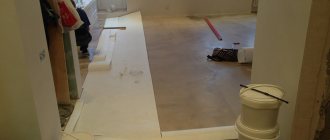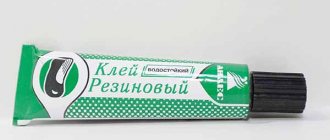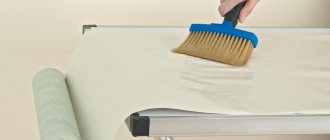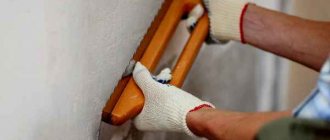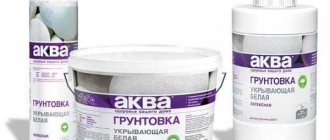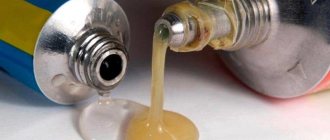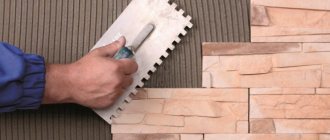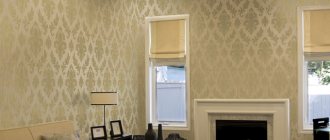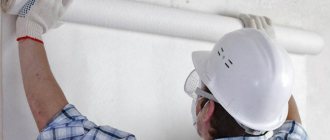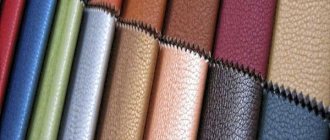Types of adhesive mixtures
Not just any wallpaper glue is suitable for gluing fiberglass. You cannot use a conventional starch-based composition with the material, since the adhesive mixture must have good adhesive characteristics and high strength.
When purchasing a product, pay attention to its packaging; there should be a mark stating that this is not simple wallpaper glue, but a product for fiberglass or sheets made of glass threads.
Some craftsmen use regular PVA for these purposes, but mixtures for professional use contain additional strengthening additives.
All products for gluing fiberglass are divided into ready-made mixtures and dry powders. Their quality is approximately the same, but their physical properties are different.
In construction stores there are fiberglass canvases that are impregnated with glue; such material only needs to be wetted before gluing it to the wall.
Ready-made adhesives
The finished composition is sold at any hardware store. It does not need to be diluted or specially prepared; it is already ready for use. Typically, glue for fiberglass is packaged in 5 or 10 liter packages, but there are large plastic buckets for professional use. Glue consumption per 1m2 is approximately 0.2-0.3 kg.
When purchasing a ready-made mixture, you need to pay attention to the expiration date, since an expired mixture has lower adhesion. Due to poor-quality products, the fiberglass may peel off or become covered with bubbles.
After opening a container of glue, the contents must be used as quickly as possible, since the mixture has a limited shelf life and quickly deteriorates.
- Most ready-mixes are made from polyvinyl acetate or polyacrylate. The polymerization process occurs after the water contained in them evaporates.
- You can glue the canvas onto acrylic paints. Then the consumption will be small, since the paint is applied in a thin layer. It has high adhesive properties.
- Polyvinyl acetate ready-mixes are made using PVA glue. PVA does not contain aggressive, harmful components, is easy to use, without an unpleasant odor. Can be used when renovating rooms where children are.
Ready-made mixtures include colloidal additives, polyvinyl alcohol, and plasticizers to strengthen the composition and prevent its delamination. Some brands add a fungicide against the growth of mold and fungi. An additional thickener is the food additive hydroxyethylcellulose. It regulates viscosity and fluidity.
Dry powder
Dry mixtures are not inferior in gluing quality to ready-made mixtures, but they must first be prepared. The powder consists of modified starch, methylcellulose, dry PVA, and technological additives. It must be diluted with water in the ratio indicated on the package. The powder is cheaper, but preparing the adhesive mixture takes time.
- If fiberglass is attached to walls for painting, then water-based paints cannot be used.
- The dried layer cannot be re-wetted.
- Powdered glue cannot be used in rooms with high humidity, even those that contain moisture-resistant additives. The painting fiberglass will not peel off completely, but it will warp, and the quality of the gluing will greatly deteriorate.
Additionally, components are mixed into the powder to increase adhesive properties and extend the service life of the coating.
Glue selection
To understand what to glue fiberglass to, you need to consider the criteria for choosing the composition. These include adhesion and strength. The solution must be in good contact with both the base and the glass fiber itself. The working platform can be a mineral or wooden (wood-fiber) surface. They are characterized by vapor permeability and the ability to absorb moisture.
Reinforcement of mineral surface Source myosu.ru
In order not to make a mistake with the choice, the best option is considered to be a ready-made composition for working with fiberglass. This is a universal composition that has good adhesion to materials with a mineral and woody nature. Dry powdery (flakes) material must be dissolved in clean water before use. Here it is important to follow the proportions recommended by the manufacturer. In order to increase the tearing and tensile strength, craftsmen recommend supplementing the solution with construction PVA in a ratio of 1 to 6. It is also permissible to use this product independently.
Before making a decision on the final choice, it is necessary to verify the expiration dates of a particular composition. The closer to the end date, the higher the likelihood of dry residue delamination. There is also a decrease in the adhesive properties of the working solution - the wallpaper does not stick.
Peeling of the canvas after painting Source blogspot.com
It is worth noting that the technology for covering walls with fiberglass differs from the rules for installing wallpaper. The glue consumption for the “web” is approximately twice as high. This point is important to consider when drawing up estimates.
Composition requirements
A high-quality mixture should contain such components.
- Plasticizers. Due to them, the adhesive surface will be elastic even after complete drying. It will not crack or burst.
- Polyvinyl acetate (PVA). Universal adhesive base without toxic components, suitable for working with most substrates.
- Fungicides. They prevent the growth of bacteria that destroy materials in the base, and prevent the development of mold, rot, and fungus.
- Modified starch.
- Bactericidal additives.
It is better to use the products that come with fiberglass, but if you buy the product separately, look at the scope of its application and the components included in the composition.
Preparing glue from a dry mixture
When using adhesive powder, you must follow the manufacturer's recommendations on the product packaging. In this case, the usual sequence of actions is as follows:
- To dilute the powder, take water at room temperature, about 20 degrees Celsius. Cold slows down the dissolution of the components and will not allow you to correctly determine the time required for this. Too warm may cause lumps to form;
- the amount of dry material and the volume of water are taken according to the manufacturer’s instructions; gluing fiberglass requires about 75 grams of glue per liter of water;
- pour the composition into the water along the edge of the dish, stirring at the same time to prevent the appearance of lumps;
- Allow the mixture to sit for five minutes to a quarter of an hour until its components absorb water, then mix thoroughly again. It is good to use a special attachment on a drill for stirring paints for this purpose.
The prepared composition can be used immediately for work; during breaks, the container is tightly closed with a lid, preventing water evaporation.
As an example, let's take dry glue Powder Plus 250 from Germany. Due to the environmental friendliness of modified starch, which is an adhesive component, it is excellent for finishing residential premises, including those that require increased attention to the quality of the environment - children's rooms. A special technology for processing starch provides exceptional adhesive ability, low mixture consumption and durability.
The optimal consistency of the adhesive, achieved by using modern plasticizers and homogenizing additives, eliminates the risk of deformation of the wallpaper and guarantees a uniform and tight fit of the fiberglass to the surface. The finished composition is a colorless mass, which, after drying, does not affect the appearance of finishing coatings.
Despite the fact that the adhesive can be used for any product, its composition is adapted to achieve ideal quality when using VITRULAN wallpaper.
Brands of adhesives for fiberglass
- Quelyd. French brand under which the universal product BluTack is produced. A popular adhesive for fiberglass is Optima. The product is packaged in 15 liter plastic buckets. Has low consumption, moisture resistant. Optima contains bactericidal and fungicidal additives. Complete drying time is 1-2 days. After gluing, you can paint the base no earlier than a day later. Can be applied with a roller by hand or by machine.
- Oscar. Produces dry powders and ready-made mixtures. Oscar glue is known for its low consumption, high adhesion and performance capabilities. The composition is safe for humans. Does not contain toxic components, meets all sanitary standards. There is a fungicide that prevents the development of mold and mildew on the treated surface. Oscar dry powder is very economical: half a kilogram of the mixture can be diluted in a 10-liter bucket of water. No lumps are formed during stirring. The finished composition is stored for no more than two months without loss of characteristics. Consumption – 0.25 kg per 1 m2.
- Pufas. Pufas adhesives are inexpensive, but have excellent adhesive ability. These are ready-made mixtures containing antifungal additives. They are not afraid of frost and are resistant to temperature changes.
- Bostik. Product based on PVA and modified starch. Apply with a roller or brush. Bostik glue is only for dry rooms. The adhesive layer will acquire full strength no earlier than a week after application. Compatible with fiberglass, fabric-based materials, paper and vinyl.
- Kleo. French manufacturer of dry powders. Cleo Ultra glue dries quickly, is reliable, easy to prepare at home and is inexpensive. After drying it becomes transparent. During dilution, the powder does not form lumps. There are no toxic components in the composition. The prepared product cannot be stored for longer than 10 days.
- Wellton. You can glue fiberglass sheets for further painting. Contains additives that increase fire resistance. Treated surfaces are not afraid of moisture and can be washed regularly. The product is environmentally friendly, safe for humans and nature.
- Bolars Fiberfix. Ready mixture, dries quickly. Release form: 5 kg eurobuckets.
Some craftsmen glue the edges and joints of glass panels with liquid nails or sealants. If you buy high-quality adhesive mixtures, then additional gluing of the joints is not necessary, they will already be reliably protected from peeling.
Ready glue
You can buy glue for fiberglass immediately and ready-made. The main type of packaging is packs and bags of dry mass for diluting in water yourself. But since canvas is often used at the surface preparation stage, in addition to the usual packaging, you can also find pre-mixed glue, similar to putties and primers.
There are a huge number of options for using ready-made adhesives:
- Made immediately according to the above recipe - starch base + PVA;
- Special “non-woven” adhesives and grades “for glass wallpaper”;
- Universal mixtures - often versatility is achieved simply by using different volumes of water when stirring.
There is no practice to recommend a specific manufacturer, but several brands are most praised:
- Oscar;
- Wellton;
- Nortex;
- CLEO.
Many manufacturers of wallpaper mixtures offer both specialized adhesive solutions and primers. It is difficult to find the difference, since the formulas and manufacturing technologies are very similar, and advertising, branding and agreements on joint promotion of wallpaper and glue play a decisive role.
Required Tools
- Rolls of fiberglass.
- Glue (both ready-made mixture and powder that will need to be diluted).
- If the powder is dry, prepare a mixing container, a construction mixer or a regular wooden stick for stirring.
- Ladder, “goats”, if you need to glue the material to the ceiling.
- Paint roller with a long handle.
- Brushes of different sizes.
- Painting tray for glue.
- Plastic wallpaper spatula.
- Tape measure, pencil.
- Level.
- Painting knife, cutter.
- Protective equipment (goggles, gloves, respirator).
Fiberglass gluing technology
Before performing work on gluing fiberglass, it is necessary to prepare the required material and tools. Fiberglass is available in rolls of various lengths and widths. When purchasing it, you need to check the integrity of the edge of the roll. If they are damaged, the integrity of the glass fibers along the entire length of the roll will be compromised. This will be accompanied by additional difficulties during the work process.
Before gluing fiberglass to the walls, you need to prepare their base. Subsequently, they proceed directly to pasting the surface and carry out the final finishing. Next, we will consider in more detail each step of the correct technology for gluing fiberglass.
Tools and materials
To work with a fiberglass structure, you will need to prepare a stepladder or other types of stands. This is necessary for the convenience of working at heights. To apply the adhesive mixture you will need to have a paint roller, preferably with a long nozzle holder, and brushes of various widths. They will be required for processing butt joints of walls. For ease of application of glue, you need to stock up on a special tray.
In the process of applying fiberglass you will need to have:
- A plastic spatula to smooth it out and remove air and excess adhesive mixture.
- A knife for cutting wallpaper is necessary for cutting the required length of the canvas and forming butt joints between the canvases.
- Measuring tape with pencil or laser level.
- Personal protective equipment.
In addition to the tool, you will need to stock up on the required amount of fiberglass, strengthening primer and adhesive mixture, depending on the size of the surface being treated.
Preparatory work
The most important factor in the initial work process is careful preparation of the base of the surface to be treated. There should be no large cracks or gouges on the walls or ceiling. If they are present, the damaged areas should be plastered, observing the time frame for drying the applied material.
Then they begin to clean the surface from dirt and dust, followed by treatment with a strengthening primer. To prevent the adhesive mixture from getting on the floor, windows, doors, you will need to cover them with plastic film.
Next, they begin to measure and cut the required length of fiberglass sheets. If you plan to use glue in dry powder form for work, then you must prepare it according to the manufacturer's instructions. Before starting work, you must close the doors and windows to prevent the formation of drafts.
Pasting with fiberglass
- The procedure for gluing fiberglass must begin from the corner. In this case, there is no need to overlap the fabric on the other side of the corner, as this will destroy the structure of the material.
2. It is necessary to mark the width from the corner and make a notch with a pencil. This will be needed to visually control the required width of application of the adhesive solution. If you have a laser level, just place the roll on the corner and align the laser line along the free edge of the web.
3. Next, the adhesive mixture is poured into a special tray and applied to the surface to be treated. At the joints of the walls, glue is applied with a brush.
4. The glue must be applied evenly over the entire area. It is better to apply in excess, since the excess will still be removed later.
5. Then the prepared fiberglass canvas is applied to the surface treated with glue. In this case, it is necessary to accurately determine the front and back sides of the fabric. As a rule, the front side is located on the inside of the roll, but it is better to check this information on the product label.
6. The canvas must be carefully smoothed, excess glue and air bubbles must be removed using a plastic spatula. To do this, you will need to walk with a spatula along the center of the canvas from top to bottom, and then from the center to the edges.
7. To ensure high-quality and durable fixation of fiberglass, it is necessary to apply another layer of adhesive solution on top of the fixed sheet. This is done using a paint roller and then removing excess glue with a plastic spatula.
8. After this, proceed to gluing the next canvas. It must be overlapped with the already pasted canvas. This is required to form a butt joint.
9. After fixing the second layer, you should take a wallpaper knife and cut the sheets along the resulting overlap. Then remove any excess material that has formed. It is not necessary to maintain the strict verticality of the cut seam. The main thing is to get a smooth transition between the connected parts of the fiberglass. In the future, you will need to additionally treat the seam with an adhesive solution. In the same way, the entire area of the surface to be treated is pasted.
When using fiberglass for finishing ceilings, it is recommended to use canvases with a maximum length of no more than 2 meters. If this value increases, the work process will be quite labor-intensive, and there is a high probability of wrinkles forming when laying the material.
To complete the process of gluing the surface with fiberglass, you need to wait a certain time for the glue to dry. Typically this will take 24 hours.
Preparation
- First you need to thoroughly clean the base. Dust and dirt are removed from the walls and ceiling, and large potholes and depressions are repaired. If the fiberglass will stick to the plaster, then the surface must be wiped several times with a wet woolen rag. Surfaces that will not be used for gluing (windows, doors, furniture, floors) are covered with oilcloth or polyethylene.
- The dry powder is diluted in the prepared container according to the instructions indicated on its packaging. You need to mix the components immediately before work, since if prepared ahead of time, the mixture may dry out and be difficult to work with. The water for diluting the mixture should be at room temperature. Stir the mixture with a stick or mixer. Afterwards, the finished product should sit for 5-10 minutes.
- Now you can start marking the dimensions of the fiberglass sheets (with a marker or pencil).
- The roll of fiberglass is unrolled and laid on the floor, the wrong side should be at the top. It is cut into strips of the required sizes in accordance with the markings made.
How to glue fiberglass - material properties
Many people think that fiberglass can only be used as a covering for walls and ceilings. But in fact, the material is used for different types of work. It is a type of fiberglass, the material consists of a large number of intersecting threads. During production, the threads are joined and then treated with modified starch. The technique is similar to the production of glass wallpaper, but the density of the canvases is different.
The degree of density of the material determines for what purposes it can be used. The back side of the canvas is rough, the front side is smooth, and their color is most often white. When finishing walls, they are usually painted.
Thick canvases are excellent for strengthening walls and provide reinforcement in corners. They are also used:
- As a base for painting or wallpaper;
- Finishing material for drywall, MDF panels;
- Waterproofing;
- Anti-corrosion treatment of pipes, glued to bitumen, mastic.
You should not use fiberglass for gluing on surfaces with putty or plaster without applying a primer solution, as bubbles may form.
Fiberglass is used in the production of various building materials and other products.
The material is a type of fiberglass, the material consists of a large number of intersecting threads.
How to glue fiberglass
When gluing fiberglass to the ceiling or walls, there should be no drafts and air humidity should not exceed 75%, otherwise the glue will not adhere well.
- First, the ceiling is covered. The surface is lubricated with glue (roller). The walls are covered in the same way.
- Height differences and corners are coated separately with a brush.
- Installation of the first strip of fiberglass. It’s better to work together: one person presses the canvas to the ceiling or wall, and the second smoothes it out, running a spatula over it to prevent bubbles from appearing. On walls, it is better to start gluing from the door, laying the sheets parallel to it.
- The second strip is glued with an overlap of 3-4 cm.
- When the entire room is glued, it can be covered again with an additional layer of glue. It increases the adhesive properties of the base, making it more durable and reliable. There is no need for priming.
Pasting corners
Very often it becomes necessary to glue fiberglass in corners, and the corner can be external or internal.
If there is unevenness or excess of the canvas in the corner, the material will need to be trimmed. This is the only way to achieve a tight fit of the fiberglass to the surface.
When gluing, both sheets of fiberglass should extend beyond the corner by 4-5 cm. To form a neat joint in the corner, you need to make a cut in the center and remove the remaining material.
Trimming excess
To make a beautiful joint, without excess material, after gluing the two canvases, you need to take a ruler and a construction knife. Carefully make a vertical cut in the middle of the overlap. Thus, both canvases will be connected at one joint, and excess strips of material will simply be removed from the surface.
How to glue on drywall
When gluing to drywall, the base must first be primed. To level the walls, first all joints and places with screw heads are puttied. Then the putty areas are sanded with sandpaper and only after that the plasterboard is primed.
Drywall is primed for less absorption (to reduce mixture consumption).
Further, the principle of gluing is similar to other bases.
Fiberglass: what are they?
Broadly speaking, the product is called fiberglass wallpaper. This is a coating that has a structure similar to fiberglass fabric. The material used is special glass. So, at a special temperature, fibers are drawn out of it. Then specialists form the yarn, and after that the material is created. Beautiful patterns are woven to create products.
It is important to choose the right glue for glass wallpaper: there are several variations of the substance. The better the composition, the easier it will be to glue the material, and the longer it will last on the walls.
Finishing of fiberglass
Painting of glued fiberglass is carried out only after it has completely dried. The walls can be painted immediately, then the fiberglass texture will remain on them, or they can be puttied first. Fiberglass fiberglass does not need preparation for putty. To achieve smooth walls, finely dispersed compounds are used and applied with a wide spatula.
You can use putty to give the walls a rough or embossed texture.
To reduce paint consumption, a layer of primer is applied to the putty. It is better to paint with acrylic, latex paints or use acrylate products. Can be applied with a roller, brush or spray gun. When the walls are completely dry, you can begin to use the room.
